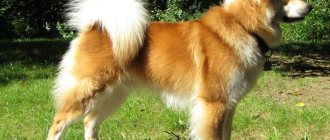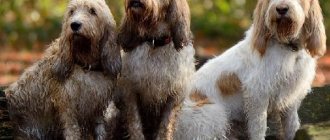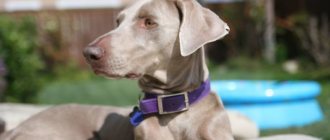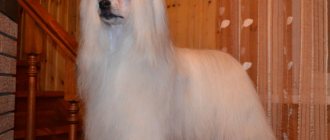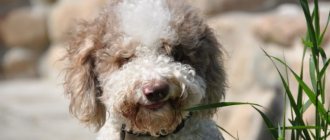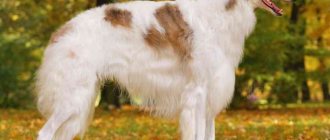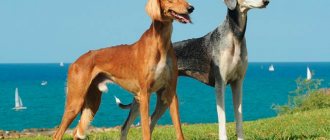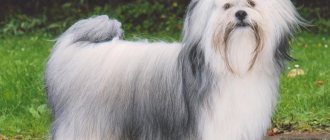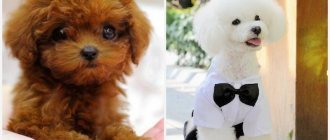History of the origin of the breed
The Italian Greyhound is one of the oldest breeds, bred from small greyhounds in Ancient Egypt. They kept the dog in the courtyards of the pharaohs. Massive mentions date back to the period of Ancient Rome, where dogs were widespread as pets. According to images found during excavations at Pompeii, they were bathed, placed on silk pillows and scented with perfume. They gained the greatest popularity during the Renaissance. Italian Greyhounds were bred for noble families and royalty.
The appearance of the classic Italian greyhound was formed in the 20-30s of the 20th century. To stabilize the phenotype, crosses were carried out with a whippet to maintain the greyhound type, and a miniature pinscher to maintain size. This scheme made it possible to preserve the breed - it needed to get rid of impurities and inbreeding.
Photo: flickr.com
History of the breed
One of the oldest types of dogs is the Italian greyhound. This fact is confirmed by archaeological finds in the form of Greek vases. These ancient artifacts date back to the fifth century BC.
It is also believed that the first representatives of the breed arrived in Italy from Greece. The formation and improvement of the Italian greyhound already took place in the Roman Empire, which is why Italy is considered the birthplace of miniature greyhounds.
The Italian Hound's purpose was to chase rabbits, but for the most part it was valued as a decorative, sofa dog.
The breed's popularity peaked during the Renaissance. The most famous artists in the world depicted Italian greyhounds on their canvases next to their noble owners.
Almost every royal palace kept Italian greyhounds. For example, miniature Italian Greyhounds were favorites of such famous people as Catherine the Second, Queen Victoria of Britain, and King Frederick the Great of Prussia.
There have been difficult times in the history of the breed. The October Revolution and both World Wars led to the almost complete extinction of purebred Italian greyhounds.
The sad fact is explained by the fact that during the revolution in Russia, the working people began to hate small dogs as pets of the rich. During the World Wars there was neither time nor opportunity to breed Italian greyhounds.
When by the twentieth century a clear threat of extinction loomed over the breed, there were breeders who began working closely to restore the numbers and purity of this species.
For the purpose of improvement, the Italian greyhound was crossed with a whippet and with a miniature pinscher. The whippet maintained the greyhound type in the breed, and the pinscher contributed to the consolidation of the miniature physique.
After the Second World War, the Italian Greyhound was revived and was no longer in danger of extinction. In 1968, a breed standard was adopted.
The Italian greyhound, having survived all the hardships, has now regained popularity in all countries of the world. It is also called the Italian Greyhound or the Small Italian Greyhound.
Description of the breed
Italian Greyhounds have an elegant and refined appearance - a true mini greyhound. Its height at the withers does not exceed 38 cm. Low weight is considered the breed standard and should not exceed 4 kg. Males are larger, but sexual dimorphism is weakly expressed.
The fat Italian greyhound is an exception. The ribs protrude well on the body and there is a good volume of muscles. Thin paws and an elongated neck contribute to fast running. At a gallop they can accelerate to 40 km/h. The structure of the head is identical to large greyhounds. It is narrow and elongated, seeming disproportionately small relative to the body. This feature enhances the aerodynamic characteristics important for running. The muzzle is narrow, dark and large eyes are set symmetrically. The nose should be black, but a brown tint is acceptable. The coat is smooth and uniform.
Colors
According to the breed standard, three colors are allowed:
- gray or blue;
- black;
- red, or isabella.
A healthy dog has a coat of uniform texture. The color of an Italian greyhound is not a key factor in evaluation in the ring; it is more important for breeding. Weak pigment can lead to alopecia, the appearance of yellowness in color. When choosing an Italian greyhound, you should pay attention to the presence of white spots. They are allowed on the chest and paws. The Italian Greyhound's puppy coat is replaced at the age of 2-4 months.
Standard
Modern breed standards for Italian Greyhounds were published in 2010. Key characteristics for exhibiting a dog in the ring:
- Frame. Weighs between 2.5-4.6 kg. The length of the body is less than or equal to its height. Average height - 38 cm. The back is straight, rounding of the lower back with a transition to the croup is acceptable. The chest is narrow but powerful. There is pronounced cancer in the abdominal area.
- Limbs. Long and thin, the muscles are dry. The paws are oval in shape, the toes are tightly knit. The claws are black or brown.
- Head. Streamlined and elongated shape. There are pronounced arches of the eyebrows, slightly thickened cheekbones. The nostrils should be well opened. The muzzle is elongated and pointed. The lips fit tightly together, dark. Jaws with a scissor bite. The ears are set high, but raised at the base. Can stand upright if the dog is alert.
- Wool. Homogeneous and uniform. There should be no undercoat. Three colors of Italian Greyhound are allowed.
- Tail. Thin and long, the end has a pronounced rounding. Provides balance while moving.
The basic posture of an Italian greyhound for phenotype assessment should be slightly relaxed. At shows, muscle development is assessed, so the dog should stand in the traditional position, when an arch appears on the stomach, with the hind legs extended back.
Here is a video from a greyhound dog show.
Puppy cost
The breed is considered elite and expensive. When breeding puppies, breeders encounter difficulties related to genetic characteristics. Only healthy individuals corresponding to functional and clinical characteristics are allowed to continue the pedigree.
Expert opinion
Anna Abramenko
An avid dog lover. Experience in veterinary medicine since 2009.
Ask a Question
It is also difficult to purchase an Italian greyhound because there are rarely more than two kittens in a litter. This factor does not allow us to provide for everyone, especially since the popularity of the breed has increased.
Today, the Internet simplifies the search for Italian greyhounds. The likelihood of quickly receiving offers after the publication of the advertisement is high. But you should prepare for the fact that you will have to go to another city or country to pick up your pet.
Alternatively, it is recommended to regularly attend competitions and exhibitions. The likelihood that a suitable dog will be found there is not very high, but you can try.
As a rule, private breeders offer babies for at least $500. In specialized nurseries prices are 2 times higher. But in this case it is guaranteed that the puppy will have a confirmed pedigree.
Character and behavioral characteristics
The Italian greyhound has an easy-going, loyal character. Capable of training and learning complex commands. In adulthood, playfulness and intelligence remain. She negatively tolerates aggression toward herself, as a result of which she becomes fearful and loses trust in people. The Italian Greyhound only shows aggression when frightened. Does not interact well with large dogs, but gets along well with small breeds.
The Italian Greyhound is good with children, but can be frightened by sudden sounds and movements. To maintain the constitution and dry muscles, the animal requires a lot of physical activity. The dwarf hound loves to run and is able to jump over fences up to 1.5 m high.
Here is a puppy playing with a cat!
Training
The Italian greyhound is not a dog that lovers of training should own. She is capable of learning as long as the classes are interesting to her. However, the simplest skills can be mastered quite easily. The main thing is to start training and socializing the puppy as early as possible. It is very important to immediately accustom your baby to walks in open spaces and the company of other dogs, otherwise she will be terrified of the street, loud sounds, and will become nervous and unsociable.
The Italian Greyhound must follow basic commands:
- place. You should strictly pronounce the word, then immediately take the puppy to the designated territory;
- ugh;
- sit is a command that is taught from 2 months. To do this, you need to raise the treat above the animal’s head while pronouncing the word. The puppy will sit down involuntarily.
- lie down - act in the same way as in the previous case, only lower the bait down;
- show your teeth;
- to me, etc.
You cannot shout at an Italian greyhound, much less hit it. You need to act exclusively with the help of praise and encouragement, but strictly.
Education and training
The Italian Greyhound, even as an adult, lends itself well to training and training. He quickly gets accustomed to using the toilet outside and reacts to contact in the presence of external stimuli. Demonstrates intelligence and ability when learning complex commands and various tricks. When choosing an activity, preference should be given to endurance disciplines - agility or discus. The Italian Greyhound is an excellent companion for any purpose, but is not suitable for working as a guide dog, hunter, or service dog.
Look how brave the Italian Greyhound is!
Photo and video review
In the photo below you can note: Italian Greyhounds, despite their fragility, are a sporting breed. Dogs are attractive and endearing, which explains their growing popularity.
Italian Greyhounds are intelligent creatures. They quickly become attached to people and feel their mood. There are no problems when communicating with such a dog. She will certainly become a loyal friend and companion.
Diseases
Despite their compact size, dogs of this breed live up to 15 years without health problems. The breed has strong immunity; difficulties arise from an unbalanced diet, early infection and non-compliance with the rules of care and maintenance. Typical diseases of Italian greyhounds:
- glaucoma;
- dystrophy of the retina or cornea of the eye;
- baldness (alopecia);
- epilepsy.
Italian greyhounds are often diagnosed with periodontal disease, and tartar forms early. This is due to large canines and a scissor bite. If the condition of the oral cavity is not controlled, teeth may begin to lose between the ages of 1 and 3 years. Some representatives of the breed have problems with the ears.
If your puppy's ears drop after vaccination, a mineral supplement with a high calcium content should be included in the daily diet.
Care and maintenance
Italian Greyhound can be kept in a house or apartment. It is worth noting that dogs of this breed often freeze and are afraid of drafts. Therefore, in case of cold weather outside, they will have to buy clothes, or rather special sets - winter, demi-season and moisture-proof. To prevent your dog from getting frostbitten paws in winter, it is recommended to buy dog shoes.
Increasingly, there is information that the delicate skin of dogs is adversely affected by the reagents used to cover roads in winter and spring. Therefore, the dog definitely needs shoes. However, this fact is not scientifically supported and most breeders believe that information about the mandatory wearing of shoes by dogs is disseminated by dog clothing manufacturers.
- Italian Greyhounds require special care for their eyes . Because the breed is prone to ophthalmological diseases. Therefore, the dog's eyes require daily examination.
- The slightest redness and cloudiness of the mucous membrane should be a reason to immediately contact a veterinarian.
- Italian Greyhounds also require ear cleaning , which should take place at least once every two weeks. You should be alert to a colored coating with an unpleasant odor, redness, baldness on the back of the ears or frequent shaking of the head, which indicates pain in the ears.
- If a dog actively and often goes for walks, then its nails will wear down naturally; if not, then they need to be trimmed. They also need to be checked for chips, cracks and delamination. Since the presence of these signs may indicate a serious illness in the dog.
- Due to the high risk of dental , it is recommended to have them cleaned regularly. To do this, you need to buy special products and a brush at the veterinary store.
Nutrition
Italian Greyhound can eat dog food . However, it should not cause allergic reactions on the dog's skin. To do this, it is worth carefully studying the composition of the selected feed. It must be natural, designed specifically for small and short-haired dogs, and the pet must eat it with great appetite.
Prohibited foods for these dogs include:
- garlic and onion;
- confectionery and flour products;
- large tubular bones;
- dried grapes;
- mushrooms and nuts;
- broccoli and potatoes;
- raw eggs.
It is noteworthy that adult Italian Greyhounds have excellent digestion. Therefore, some representatives of the breed eat only once a day. In this case, puppies need to be fed at least three times a day.
Italian Greyhounds can be fed buckwheat and brown rice . They also love steamed vegetables and boiled meat. It could be chicken, beef or veal. Pets of this breed often require protein, the source of which can be boiled chicken or quail eggs.
Health
Italian Greyhounds live no more than 15 years. These are quite sickly dogs. This is mainly due to the lack of subcutaneous fat and short hair. That is why it is recommended to dress them warmly during cold periods.
Vaccinations
The breed is vaccinated against the following diseases:
- plague;
- parvovirus and parainfluenza;
- viral hepatitis;
- rabies;
- leptospirosis;
- coronavirus;
- trichophytosis.
The first vaccination is given at 2 months . After this, the dog is prohibited from bathing, overfeeding and walking for two weeks. At this time, the Italian greyhound develops immunity. This period is considered the most dangerous for the pet's health. Since most dogs develop a high fever, general weakness and diarrhea appear.
The second vaccination is carried out three weeks after the first. As a rule, it already passes without complications. However, even at this time, the dog should be isolated from other pets, fenced off from drafts and stopped walking. Isolation must continue for two weeks .
When the dog is six months old, it is vaccinated against rabies and several other diseases. After another six months, comprehensive vaccination is carried out. After this, vaccination is carried out once a year.
Diseases
This dog has many hereditary diseases:
- cataract;
- periodontal disease;
- glaucoma;
- alopecia;
- cryptorchidism in males;
- epilepsy;
- mammary cancer;
- thyroid dysfunction;
- dermatitis;
- navel hernia;
- ectromelia;
- baldness;
- congenital deafness.
Walk
This breed of dog requires long and active walks in the fresh air, which is due to their highly active and playful disposition. The minimum time for one walk is 2 hours. Moreover, there should be at least two such walks a day. Therefore, if you don’t have such time, then it’s better to forget about buying an Italian greyhound puppy.
It will not be superfluous to visit sports grounds with your dog that are specially equipped for training. Given the pet's high intelligence and good memory, it can be taught any dog tricks.
Swimming is a great way to keep your dog in good physical shape. To do this, you can use any body of water located near your home.
Grooming
- Caring for the coat involves combing with a rubber brush.
- Although the dog of this breed is considered short-haired, their shedding is very noticeable, especially for females.
- Brushing the coat daily with a rubber brush will minimize coat changes.
- It is recommended to bathe an Italian greyhound only during the season or when absolutely necessary. This is due to the fact that these dogs have very sensitive skin. Therefore, even small contact with water seriously damages the outer layer of the skin.
- As detergents, you can only use specialized shampoos designed for short-haired dogs with sensitive skin.
Pregnancy
Puberty of the Italian greyhound begins at 8-10 months. It is advisable to carry out mating only in the second year of life, when the first 2-3 heats have passed. Mating is preferably on the territory of the bitch, where she will feel more comfortable. For mating, it is recommended to choose individuals that have similar color and dimensions.
Pregnancy lasts about 60 days; to monitor your health, it is worth keeping a detailed diary immediately after mating. Young bitches have small litters and sometimes require a caesarean section. Italian Greyhounds have a pronounced maternal instinct and do not show aggression towards puppies. Pregnant Italian hounds remain active and mobile until late pregnancy.
But the bitch feeds her puppies.
Story
Mention of short dogs is found in manuscripts of Ancient Rome and Egypt. Most dog handlers believe that the first representatives of the breed appeared in Greece and Turkey.
There is another opinion associated with the statement: the spread of the original small dogs began in Egyptian and Persian territories.
The Italian greyhound became popular in Europe in the 17th century. She was brought to England from Italy, where she immediately became a favorite of the aristocrats. In those days, other names for the breed became common, focusing on the original appearance.
Italian greyhounds were used for hunting. The Italian greyhound's goodwill and devotion contributed to her being in demand in high-ranking circles. These dogs were close to many historical figures.
This is interesting: Types of greyhound dogs
Care
The breed is intended for home keeping only. Short hair without undercoat does not allow the dog to withstand frost; in winter, it is recommended to wear insulated overalls for walking. Care instructions:
- To maintain cleanliness, the dog must be cleaned and washed; a furminator cannot be used;
- Italian Greyhounds are active dogs; walking should be constant and long. It is recommended to provide opportunities for running;
- You should brush your teeth monthly to prevent tartar buildup. For prevention, give bones and hard treats;
- The dog should have its own place in the house. For Italian Greyhounds, it is recommended to purchase a soft bed with low sides.
Training can begin at 4-5 months, when vaccinations are completed. You immediately need to wean your Italian greyhound from chewing furniture, things and relieving itself in the house.
Photo: wikimedia.org
Selection of accessories
What is required for content:
- It is recommended to purchase bowls made of metal - they are easy to clean and have an extended service life. It would be desirable to be able to adjust the height to suit your height;
- The collar for an Italian Greyhound should be wide, as the breed has a long and thin neck. The harness can only be used by adults;
- Having clothes is a mandatory requirement for walking. You need to have at least two overalls or capes for walking in the warm and cold seasons.
You should get an engraved address card with the owner’s contact information. This allows you to find an escaped animal. For walking, you can use both a leash and a tape measure.
Feeding an Italian Greyhound
The diet of a miniature greyhound should consist of:
- large pieces of beef with films and cartilage - this is healthier for digestion, as well as bones and joints;
- fillet of lean sea fish (for example, the cod family), it is better to scald it first;
- low-fat homemade cottage cheese;
- cereals, for example, rolled oats, unpolished rice;
- vegetable salads seasoned with vegetable oil;
- greens (parsley and dill);
- vitamin and mineral complexes (with the fragility of the Italian greyhound, calcium is especially important);
- clean water.
It is forbidden to give dogs fried, fatty, sweet, flour, salty, smoked and spicy food. Many foods can cause allergies in Italian greyhounds: horse meat, buckwheat, egg white, etc.
If there are difficulties in preparing a balanced diet, the best option would be premium and super-premium industrial food for small breeds, for example:
- Grandorf Adult All Breeds 4 Meat & Brown Rice Hypoallergenic;
- Piccolo Small Dogs Salmon & Venison;
- Applaws Adult Dog Small & Medium Breed Chicken Grain Free Hypoallergenic;
- Brit Care Adult Dog Small Breed Lamb & Rice Hypoallergenic;
- Eukanuba Adult Small Breed.
Photo gallery: industrial food for Italian greyhounds
Hypoallergenic food Grandorf Adult All Breeds 4 Meat & Brown Rice contains turkey, duck, rabbit and lamb meat
Piccolo Small Dogs grain-free salmon and venison food is suitable for miniature dogs
Hypoallergenic food Applaws Adult Dog Small & Medium Breed Chicken Grain Free consists of chicken meat and vegetables
Brit Care Adult Dog Small Breed Lamb & Rice Hypoallergenic food contains lamb meat, as well as crustacean shells and cartilage extract, ensuring the health of the musculoskeletal system of small breed dogs
Eukanuba Adult Small Breed food contains poultry meat and a complex of polyunsaturated fatty acids
Feeding
Italian greyhounds can be kept on natural food or dry food. The second option is preferable, since the composition contains all the necessary elements for health, a balanced proportion of BJU.
Any premium or holistic brand will do; the amount of protein and calorie content depends on the pet’s regular physical activity. The daily amount of feed depends on age, weight and brand of food. Italian Greyhound puppies should be given additional mineral supplements to maintain health.
Health and illness
The lifespan of an Italian Greyhound largely depends on its physical activity. With proper activity, the dog lives up to 16 years. Despite their thin appearance, representatives of this breed are distinguished by good health. But there are still some diseases to which these dogs are especially predisposed.
Possible diseases of the dog
- diseases of the teeth and gums, plaque, loss of incisors, periodontal disease, tartar;
- ophthalmological diseases (retinal atrophy, cataracts, corneal dystrophy, glaucoma) are fraught with complete loss of vision if not treated on time;
- epilepsy (rare);
- alopecia (bald spots and dermatitis, i.e. baldness), to avoid it is necessary to wash your pet only with special shampoos, preferably dry ones;
- cryptorchidism.
In addition, we must not forget that the Italian greyhound's bones are fragile, despite the fact that she loves to run fast and jump high. And this is fraught with injuries. So it is necessary to train your pet to control itself. Any illness or injury affects a greyhound's lifespan.
To avoid any diseases, it is recommended to take your dog to the veterinary clinic for examination every six months. In this case, it is quite possible that she will never get sick in her entire life.
Tips for choosing puppies
It is recommended to purchase a dog from a trusted breeder or kennel. What to look for:
- living conditions, quality of food and condition of the bitch;
- activity of puppies in the litter;
- clean skin, ears and eyes;
- RKF certificates confirming the pedigree and the absence of genetic defects of the parents.
Italian Greyhounds are ready for weaning no earlier than 2-3 months - until this age they receive all the necessary substances from their mother's milk.
Photo: wikimedia.org
Features of feeding and diet
When choosing a suitable diet, you can give preference to both dry and homemade food. The main thing is to ensure that the dry food is of the appropriate size - the Italian greyhound simply cannot chew large granules due to its tiny jaws.
On a note! By giving your dog 50 grams of kefir per week, you can guarantee stable and uninterrupted bowel function.
Homemade food should be balanced, that is, when preparing it, you need to use meat (lean, like beef, poultry or rabbit), cereals (wheat, millet, buckwheat, rolled oats are best) and vegetables (pumpkin, zucchini, carrots). Once a week, meat can be replaced with fish.
In addition, your pet can be fed boiled offal (liver, heart, kidneys) 2-3 days a week. This is not only cheaper, but also provides your pet with all the microelements necessary for a long life.
The main thing is that the diet is moderate - otherwise there is a risk of developing obesity.
No one can resist such a look
Owner reviews
Anna G. “An Italian greyhound has been living in our family for 5 years. This is a very smart, active and inquisitive dog. We get vaccinated and brush our teeth every year. Gets along well with the child, never shows activity. He loves to eat, he needs to limit food portions - he can eat everything he sees.”
Kirill U. “We got an Italian greyhound last year. In the first 3 months, Joy ruined all the shoes in the house and the legs of the chairs. It took us a long time to wean ourselves off this habit. Today it is a real member of the family! He tolerates the car well, loves to run outside and chase the ball. I recommend this breed for a small apartment.”
Wind toy, or Italian Greyhound in painting
Today my story is dedicated to the Italian greyhound in painting.
The wind toy, the hare, the Italian greyhound and the small Italian greyhound are all one dog - the Italian greyhound. And this is not a typo: not decorative, not sofa-like, but precisely - Greyhound! The Italian greyhound is the smallest representative of the group of greyhound breeds. A dog up to 38 cm at the withers, no more than 5 kg - one of the most fragile and incredibly graceful dogs. A dog that knows for sure that it is of blue blood and looks down on representatives of other breeds. The Italian Greyhound belongs to the oldest breeds on the planet. And it is unknown whether Italian greyhounds descended from the large English greyhound or vice versa. There is a version that the Italian greyhound was the first companion for humans. There is also an opinion that the Italian greyhound was bred to hunt small game.
From cave paintings to modern photographs, the Italian Greyhound is one of the most depicted dogs and rivals horses. Very often the Italian greyhound is depicted in women's portraits. Of course, there couldn’t be anything more graceful in the world. Even in Sumerian writing you can find a symbol resembling an Italian greyhound. The earliest images of Italian greyhounds were found in the tombs of the pharaohs of ancient Egypt. It is believed that Italian greyhounds were brought to Europe by Julius Caesar as a gift to Cleopatra. It is also believed that on amphoras from Etruria 540 BC. Italian greyhounds are depicted. All European Italian greyhounds are descendants of Egyptian ones.
Fresco from the tomb of Ipui
The Italian Greyhound has always been the dog of the royal and richest courts of Europe. She was valued for her incredible grace, dexterity, playfulness, agility, devotion and for her very strong hunting instinct. In Europe, the Italian greyhound has always been a hunter. It is believed that over time, the Italian Greyhound was used for “female” hunting by royalty and significant courts in Europe. It was a hare hunt. Nowadays it is not customary to hunt with Italian Greyhounds. But greyhounds more than prove their qualities in coursing courses, often giving a head start to even the taller and fastest representatives of greyhounds - greyhounds.
The most frequent depictions of Italian Greyhounds in paintings begin in the 15th century. It is interesting that she was depicted not only in subject and portrait painting, but also on canvases painted on biblical themes, as a symbol of virtue. Italian Greyhounds were kept by monarchs of many countries. But Frederick the Great, perhaps, surpassed everyone. He kept up to 300 Italian greyhounds. He even took them with him on military campaigns. When his favorite Italian greyhound Bishe died, Friedrich and Voltaire followed her coffin.
Albrecht Durer. Saint Eustathius on the hunt. Copper engraving (circa 1505)
The Torment of Saint Ursula, Hans Memling, 1489
School of Hieronymus Bosch. Adoration of the Magi. 1474-1516
Honoré III (Prince of Monaco), 1730
Alphonse de Lamartine and his Italian Greyhounds
Anna of Denmark
Princess Wilhelmina with her brother Frederick, by Antoine Paine
Leopold Clement, Prince of Lorraine, 1710
Wilhelmina von Lichtenau
Eos, the favorite dog of Queen Victoria's husband, Prince Albert
Greetings to Russia Italian Greyhounds Peter the Great. It was a gift from the King of France to the Russian court. But Catherine II surpassed everyone with her love for Italian greyhounds. She considered them family. And I must say - rightfully so. Catherine II received her first Italian greyhounds as a gift from the English doctor Thomas Dimmesdale: Sir Tom Andersen and Duchess. This was the beginning of the “fashion” in Russia for these dogs.
In Tsarskoe Selo there is a pyramid, the tomb of the imperial Italian Greyhounds. Once upon a time, on the tombstone of Catherine’s favorite, Italian greyhound Zemira, it was written “Here lies Zemira, and the saddened Graces should throw flowers on her grave. Like Tom, her ancestor, like Lady, her mother, she was constant in her inclinations, easy on the run and had only one drawback: she was a little angry, but her heart was kind. When you are afraid to love everything, and Zemira loved the one whom the whole world loves as much as she does. Is it possible to be calm with the rivalry of so many nations? The gods, witnesses of her tenderness, should have rewarded her for her loyalty with immortality, so that she could be inseparably with her mistress.”
Catherine II with her beloved Italian greyhound Zemira. In the background is the tomb of the lekrets.
In Russia, Italian greyhounds disappeared after the 1917 revolution. And only in the 1970s, Moscow breeders revived this breed, bringing a pair of Italian greyhounds from Italy. Currently, Italian Greyhounds are rarely depicted in easel paintings. More often, the Italian greyhound inspires picturesque depictions of its owners, and in photographs, it inspires owners and artist photographers. In my opinion, it is the artistic photographs of today that most accurately convey the stature, temperament, emotionality, excitement, tenderness, devotion and grace of the Italian greyhound. But this post is about painting.
Below are paintings featuring Italian Greyhounds.
Enjoy!
Painting by V. Serov. 1899
Vittorio Reggianini, girl with Italian greyhound
Advantages and disadvantages
Advantages of the breed:
- decorative, beautiful appearance;
- miniature sizes;
- absence of serious congenital diseases;
- learning ability, intelligence;
- simple care and maintenance;
- ability to get along with children.
Among the disadvantages are:
- predisposition to periodontal disease;
- intolerance to low temperatures;
- When exposed to strong stimuli, the dog becomes fearful.
Photo: pixabay.com
Advantages of the breed
While in the apartment, the pet behaves restrained and relaxed. He enjoys playing with his owner and lying on the couch with him. If we talk about the advantages of the Italian greyhound, then she is energetic, friendly, and clean. If a pet grew up in a private home, it will be more friendly and active, since in these conditions it will spend more time outdoors. If we talk about training abilities, it is worth noting that the German Shepherd is smarter than the Greyhound. Some animals can be called homebodies: they would gladly not leave the apartment. Italian Greyhounds live a long time, on average 13 years.
Similar breeds
All dogs related to greyhounds have similar external characteristics. There are several dogs similar to the Italian greyhound:
Greyhound (English greyhound)
It is believed that it was from this breed that the small Italian greyhound was bred. These are large dogs whose weight can reach 40 kg. The coat is smooth, possible colors are white, red, blue, brown, sand and black. One of the fastest breeds in the world.
Photo: wikipedia.org
Whippet
This dog is distinguished by its larger size, wide range of colors and overall appearance. Has pronounced watchdog qualities and temperament. Occupies an intermediate position between the Italian Greyhound and the Greyhound. Used for hunting.
Photo: wikimedia.org
Italian Greyhounds, unlike other breeds in the class, are not used for working tasks today. They have lost their guard and hunting skills. In addition, they were originally bred as an ornamental pet.
How to choose a puppy
First of all, before purchasing, you need to decide on the breed. For example, when choosing between a Chihuahua and an Italian greyhound, it is worth considering that both dogs are delicate and fragile. Sneezes more often have congenital diseases, but need walks less than Italian greyhounds. If you still choose an Italian, you should think about whether she will participate in exhibitions or just need a companion dog. An exhibition specimen is much more expensive due to its exterior, but to a non-professional, Italian pet-class greyhounds look no worse.
The main thing is to choose a healthy individual. It is worth paying attention to the following parameters:
- a two-month-old puppy should have six teeth on top and bottom;
- the tail is straight, without bends;
- acceptable color;
- There should be no umbilical hernia.
A small greyhound should be active. It is especially good if she herself goes into the arms of a potential owner and strives to start a game.
Photo
Photo: wikimedia.org
Photo: wikimedia.org
Photo: pixabay.com
Photo: wikimedia.org
Psychology
The Small Italian Greyhound is a very affectionate and gentle dog. The Italian greyhound, whose photos are increasingly being posted by owners on social networks, resembles a cat in its character.
- Flexibility of character. The Italian greyhound knows how to adapt to the lifestyle of its owner. In an active and sporty family, she will behave appropriately, and in a society of homebodies, she will not require physical activity, but will be able to surround her owner with her love.
- Curiosity. It is extremely necessary for the Italian Greyhound to stick its nose everywhere. She will follow you around so that she knows what you live and are interested in.
- Spoiled. It's easy to spoil an Italian Greyhound - you just need to give in once and give in to it.
- Playfulness. Italian Greyhound is a playful dog. If you have a child in the house, best friends are hard to find. Together they will be interested in rummaging through a pile of toys and taking them apart. The only thing is that the Italian Greyhound may become jealous of the child’s toys. Therefore, the dog must understand that the child has a more significant word than she does; the child is also the owner.
It is extremely necessary for the Italian Greyhound to stick its nose everywhere. She will follow you around so that she knows what you live and are interested in.
- Activity. Italian Greyhounds are very active. On the street they resemble a small hurricane - everyone rushes and jumps.
- The desire to be on top. One thing the Italian Greyhound exactly resembles cats is its love of sitting on top. Whether it’s an armchair, the back of a sofa, a bedside table or a closet, a small greyhound will certainly climb up and watch what’s going on around it. The Italian Greyhound can be considered essentially a smaller version of the Irish Wolfhound .
- Impressionability. The dog is easily frightened and made to tremble. It is necessary to protect her impressionable nature from loud sounds, otherwise the dog will begin to rush around the house in horror, demolishing everything in its path.
Important! Italian Greyhounds can get along well with their breedmates in the same home, but they are very wary of other dogs and cats.
Most often these days, the Italian Greyhound is chosen as a decorative dog or a pet.
Briefly about the main thing
- Italian Greyhound is an elegant breed from the hound class. Ideal for keeping in an apartment due to its small size. Gets along with children.
- The pet is easy to care for; the fur does not need to be combed from the undercoat.
- Good learning ability, ability to master complex commands.
- The dog's activity and energy make it possible to use it as a running companion.
Tell us in the comments about your experience of keeping an Italian greyhound. What difficulties have you encountered in the process of raising a pet?
Did you like the article? Share it with your friends on social media. networks. This will help them get useful information and support our project.
Character
A distinctive character trait of the Italian greyhound is the ability to subtly sense the mood of the owner and the ability to adapt to him.
Such a dog is willing to share the owner’s lifestyle, as long as he does not leave him alone. To prevent the Italian greyhound from suffering while the owners are away, it is recommended to keep several pets of this breed at once. They get along well with each other.
The Italian Greyhound is a very sensitive animal. He cannot tolerate sharp, loud sounds, although he himself reacts to any irritant with a loud, sharp bark.
If such a dog is treated roughly, it will become depressed or turn into a frightened creature, trembling at the slightest rustle. Affection, attention, care from the owner are a vital condition for keeping.
Owners of miniature greyhounds compare their pets to cats. All because of their desire to find a higher place, climb there and watch everything that happens. This could be a closet, a table, the back of a chair or sofa.
The Italian Greyhound gets along well with children and readily plays with them. He behaves friendly with small dogs; he avoids and is afraid of animals that are larger in size.
He does not show trust in strangers until he is convinced of their friendly intentions. But even after establishing contact, the Italian greyhound will be on guard if a stranger is nearby.
Dog training
Italian Greyhounds, although they respect people, are capricious and require willpower and perseverance to properly raise them. Thanks to their pitiful gaze that penetrates the soul, greyhounds easily find gaps in a person’s character and use them for selfish purposes. Therefore, when raising a greyhound, show character and clearly explain to it who is more important.
It is difficult to train Italian greyhounds - they do not have high intelligence. But you need to teach your pet basic commands. Everything will work out - it’s worth putting more effort into it. There are no stupid dogs.
Train your puppy from the first day he arrives at home - teach him to behave correctly. You should punish your pet only for obvious crimes committed before your eyes.
Small Italian Greyhounds love outdoor games, running, jumping and can participate in dog sports competitions with their owner.
Nutrition
The best nutrition is a special, balanced diet. But today manufacturers do not produce adapted food for Italian greyhounds. With such a thin and graceful appearance, they can withstand incredible physical stress. So you should pay special attention to feeding your pet:
- Meat forms the basis of the diet; it must be of high quality and free of fat. Moreover, the Italian greyhound will be more happy with a piece of meat that has been sitting down with films and cartilage than with a steamed tenderloin. The meat should be cut into small pieces without turning it into minced meat.
- By-products can be included in the diet, but they should not be an alternative to meat, and besides, they are heavy on the stomach.
- Cereals should not form the basis of the diet. Unpolished rice, rolled oats, millet, and buckwheat can be given as a separate meal.
- Fruits are given as a treat or between meals; in winter, dried fruits are acceptable.
- Dairy products in small quantities will not harm your Italian Greyhound. Fresh, low-fat homemade cottage cheese without a sour taste is especially useful.
- Only marine fish of the cod family.
- Bones are acceptable in the Italian Greyhound's diet if your dog does not chew them, but knows how to carefully gnaw off pieces of meat and cartilage.
Photo of Italian Greyhound
You can see a photo of the Italian Greyhound breed below; it has made quite a big contribution to the fine arts.
In many paintings, ladies of high society were depicted with their favorites. Nowadays, a photo of a dog is becoming an element of the portfolio of many famous photographers. Descriptions of these four-legged friends almost always begin with the words sophistication and elegance. Since ancient times, the Italian greyhound breed has been associated with aristocracy. If you feel that you are missing this, then this dog will be a good solution. Just don’t forget that, even if it’s small, it’s still a greyhound.
Advantages and disadvantages
If a dog is properly trained, it is difficult to find a more devoted, affectionate and dutiful dog. The Italian Greyhound is considered an ideal dog breed that can predict the emotional state of the owner. She perfectly distinguishes the smallest shades of voice timbre and intonation.
The average body temperature of a dog is 39.5°C. Many aristocrats kept them as warmers when tucking a pair of Italian greyhounds into bed. Both Nefertiti and Catherine the Great did this, claiming that dogs relieve arthritic pain in the knee joints, inducing a calm, deep sleep.
Long-legged, weighing up to 3.5 kg, the dog is compact. Folding into a small ball at the bottom of the bag, it can travel with its owner in any direction. A very loving dog, attached to the owner with all his heart. Her nature requires the constant presence of her owner nearby, showing the skills of a gentle and affectionate companion.
Italian greyhounds also get along well with each other and representatives of other breeds. An owner can have two, three, or even four Italian greyhounds at the same time. Gathering into a friendly flock, they happily greet the owner and all family members, experiencing the process of forced waiting several times more calmly.
The disadvantages include the fact that during a long separation from the owner, as well as in a stressful situation, the Italian Greyhound may fall into a state of destruction. Even family members may not be able to influence the dog's return to normal.
The impressionability of the Italian Greyhound is sometimes off the charts. The slightest fear leads to uncontrollable trembling of the whole body, right to the very tip of the tail. She is frightened by loud sudden sounds, upon hearing which the dog begins to rush about, not seeing anything in its path.
The disadvantages sometimes include the fact that the price of an Italian Greyhound dog is quite high, and the older the Italian Greyhound, the more expensive it is.
Reviews
Anka the Spaniard:
I have had this breed for a long time. Now I have a couple of the sweetest and most devoted creatures. Lucky with the characters of the dogs. They are quiet, calm and do not bark at all. In winter they sleep at my feet - it’s warmer.
Christina:
I had an Italian greyhound for a long time. They must be from another planet. An aristocrat to the core, she could immediately return to her bag out of resentment. I was always freezing and huddled close to the radiators. She was terribly afraid of the streets, although I had taken her on a leash since she was a puppy in the most crowded places. Then, at the dacha, she chewed the leash and left. I searched for a long time, but to no avail. She was almost 11. Apparently she was offended by something.
